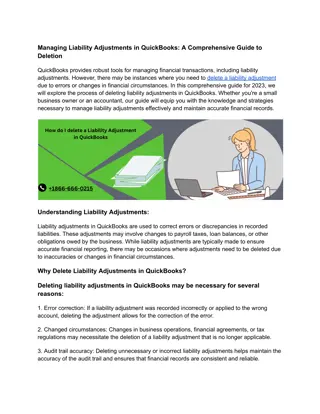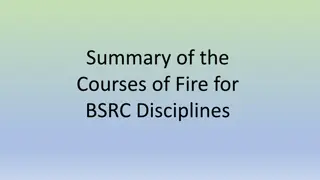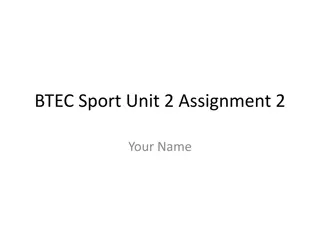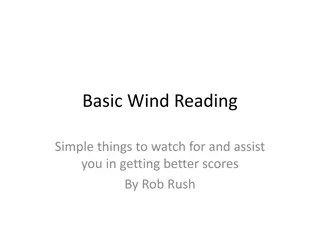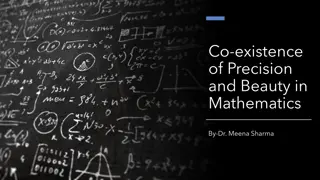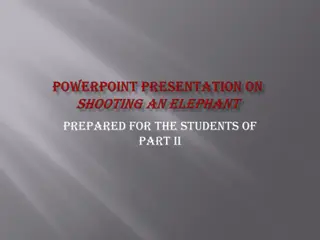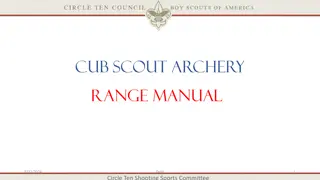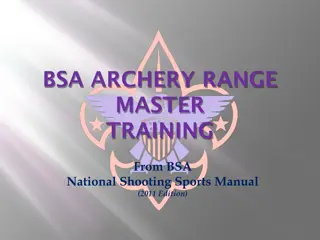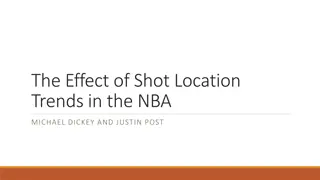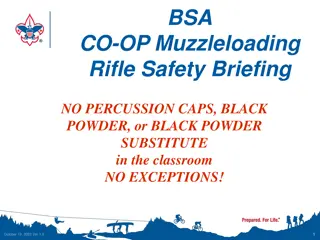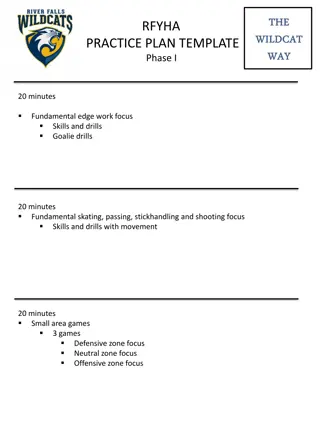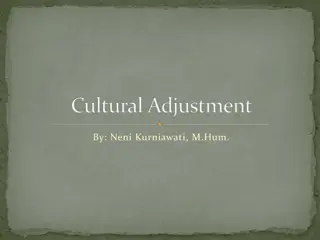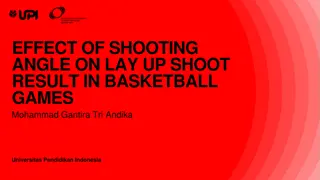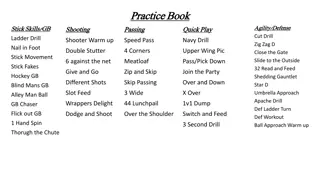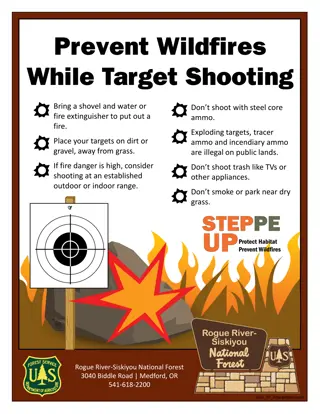Precision Shooting Techniques & Adjustment Guidelines
Learn about Minute of Angle (MOA), adjusting windage & elevation, bullet drop compensation, parallax correction, and precision shooting techniques for optimal accuracy. Understand the impact of factors like wind, distance, and rifle adjustments on grouping size and point of impact.
Download Presentation

Please find below an Image/Link to download the presentation.
The content on the website is provided AS IS for your information and personal use only. It may not be sold, licensed, or shared on other websites without obtaining consent from the author.If you encounter any issues during the download, it is possible that the publisher has removed the file from their server.
You are allowed to download the files provided on this website for personal or commercial use, subject to the condition that they are used lawfully. All files are the property of their respective owners.
The content on the website is provided AS IS for your information and personal use only. It may not be sold, licensed, or shared on other websites without obtaining consent from the author.
E N D
Presentation Transcript
300m 200m 100m 1 3 2 Minute of Angle M.O.A. or Moh Ah Derived from imperial measurements of Degrees, Minutes, Seconds of angle (rather than Mils) Angle of uncertainty between point of aim and point of impact Results in a grouping of impacts C7 capable of 1 MOA which is approximately 1 at 100yards (close enough to 1 at 100m) Angle of uncertainty is consistent at all distances. Factors such as wind and bullet drop have minimal effect on grouping size Gauge of Precision C7 with Military ammo (62gr ss109 bullet) Bullet drop increases significantly over distance Specific adjustment may change based on shooter and rifle Elevation also needs to be adjusted based on barometric pressure Generally follows the rule of Sun s Up Sights Up adding 1 extra click of elevation on sunny warm days Distance (m) 100 200 300 400 500 Drop in Inches 0 2 9 24 50 # Clicks adjustment (from 100m Zero) 0 1 3 6 10
Windage Elevation Requires a Quarter or similar washer to adjust! Two disks: 1. Pre defined distances (rough estimates) Disk Lock 2. Zero disk with fine adjustment to set the Sight zero Arrow points in direction to adjust to RIGHT gate should be up to adjust the Fine disk independently from the pre set disk Unlike Windage disk, UP has an indicated direction Mounting Screws Uses Mil Std 1913 mount Keep Tight! C-79 Sight - each click is approx. 1 at 100m (technically, .85MOA) Good Eye Relief Zero Parallax Consistent shots Good PRECISION Poor Eye Relief 3.7x magnification Parallax Will shift between shots Reticle has a 70mm Eye Relief so sight needs to have its position on the C7 adjusted based on shooter s ergonomics Inconsistent -Poor PRECISION Incorrect eye position will result in PARALLAX Parallax is the difference between perceived POA and POI Zero Parallax means POA and POI are the same Point of Aim POA The place on a target you want to hit Point of Impact POI The place on a target you actually hit
Windage Wind has minimal effect from 0-100m, each subsequent 100m has greater effect assuming constant wind 3. Multiply Drift by ratio based on Direction 1. Gauge Wind Speed 2. Find Drift for speed at distance 4. Apply windage to Sight Speed (kph) Description <1 Smoke rises vertically Direction of wind shown by smoke drift 6-11 Wind felt on face 12-19 Wind extends light flag 20-29 Raises dust and loose paper 30-38 Small trees in leaf begin to sway 39-50 Large branches in motion Whole trees in motion; inconvenience felt in walking against wind 61-70 Slight structural damage 71-85 Trees uprooted Wind Drift in INCHES Range in metres Speed (kph) 200 300 5 2/1 4/1 10 3/1 8/2 15 5/2 12/4 22/5 20 6/3 15/5 29/7 50/10 25 8/4 19/6 37/9 62/12 30 10/5 23/8 44/11 74/15 Remember: Wind is usually referred to by direction it is coming FROM. Adjust windage to SAME direction. IE: Wind is coming from the LEFT, adjust sights to the LEFT 0 0.5 0.5 2-5 400 8/2 15/4 500 14/3 26/5 38/8 1 1 0.5 0.5 0 51-60 At ranges closer than 100m, the distance between the center of the rifle bore and the center of the sight affects Accuracy Adjust elevation to longer distances to compensate
Target moving LEFT 300m Target moving RIGHT 100m 100m 50m 50m Target moving RIGHT Target moving LEFT Target moving LEFT Target moving RIGHT 300m 200m 200m Knowledge CAFSAC range instructions, words of command are minimalist Each competitor is obliged to know each stage of each match ahead of time Only instruction: Match X, Load, Ready. Watch and Shoot Mental Mantra prior to each stage: Sights, Safety, Wind, Prepare to move Sights Adjust elevation for next stage Safety Magazine for next stage loaded, readied, safety ON Wind Take the opportunity to check wind, adjust windage before next stage Prepare to move Go from a shooting stance to similar prep stance (ie from a tight kneel to high kneel) and trail arms
2. Find Drift for speed at distance Distance (m) 100 200 300 400 500 Drop in Inches 0 2 9 24 50 # Clicks adjustment (from 100m Zero) 0 1 3 6 10 Wind Drift in INCHES Range in metres Speed (kph) 200 300 5 2/1 4/1 10 3/1 8/2 15 5/2 12/4 22/6 20 6/3 15/5 29/7 50/10 25 8/4 19/6 37/9 62/12 30 10/5 23/8 44/11 74/15 400 8/2 15/4 500 14/3 26/5 38/8 1. Gauge Wind Speed Speed (kph) Description <1 Smoke rises vertically Direction of wind shown by smoke drift 6-11 Wind felt on face 12-19 Wind extends light flag 20-29 Raises dust and loose paper 30-38 Small trees in leaf begin to sway 39-50 Large branches in motion Whole trees in motion; inconvenience felt in walking against wind 61-70 Slight structural damage 71-85 Trees uprooted 3. Multiply Drift by ratio based on Direction 2-5 0 0.5 0.5 1 1 51-60 0.5 0.5 0 Remember: Wind is usually referred to by direction it is coming FROM. Adjust windage to SAME direction. IE: Wind is coming from the LEFT, adjust sights to the LEFT 4. Apply windage to Sight
Wind Drift in INCHES Distance (m) 100 200 300 400 500 Drop in Inches 0 2 9 24 50 # Clicks Range in metres Spd (kph) 5 10 15 20 25 30 200 300 1 1 2 3 4 5 400 2 4 6 7 9 11 500 3 5 8 10 12 15 0 1 3 6 10 1 2 4 5 6 8 Spd (kph)Description <1 Smoke rises vertically 2-5 Direction shown by smoke drift 6-11 Wind felt on face 12-19 Wind extends light flag 20-29 Raises dust and loose paper 30-38 Small trees in leaf sway 39-50 Large branches in motion 0 0.5 0.5 1 1 51-60 Whole trees in motion 0.5 61-70 Slight structural damage 71-85 Trees uprooted 0.5 0 Wind Drift in INCHES 0 Range in metres 300 400 1 2 4 5 6 8 Spd (kph) .5 kph <1 2-5 6-11 Wind felt 12-19 Flag extends 20-29 Raises dust 30-38 Small trees sway Description Vertical smoke smoke drift .5 Dist Drop #Clicks 100 0 200 2 300 9 400 24 500 50 200 1 1 2 3 4 5 500 3 5 8 10 12 2 4 6 7 9 11 15 5 0 1 3 6 10 1 1 15 20 .5 .5 25 10 0 30





